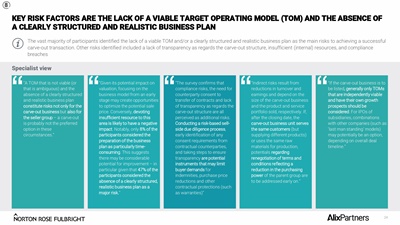
24
Specialist view
KEY RISK FACTORS ARE THE LACK OF A VIABLE TARGET OPERATING MODEL (TOM) AND THE ABSENCE OF
A CLEARLY STRUCTURED AND REALISTIC BUSINESS PLAN
The vast majority of participants identified the lack of a viable TOM and/or a clearly structured and realistic business plan as the main risks to achieving a successful
carve-out transaction. Other risks identified included a lack of transparency as regards the carve-out structure, insufficient (internal) resources, and compliance
breaches
"A TOM that is not viable (or
that is ambiguous) and the
absence of a clearly structured
and realistic business plan
constitute risks not only for the
carve-out business but also for
the seller group - a carve-out
is probably not the preferred
option in these
circumstances."
"The survey confirms that
compliance risks, the need for
counterparty consent to
transfer of contracts and lack
of transparency as regards the
carve-out structure are all
perceived as additional risks.
Conducting a risk-based sellside
due diligence process,
early identification of any
consent requirements from
contractual counterparties,
and taking steps to ensure
transparency are potential
instruments that may limit
buyer demands for
indemnities, purchase price
reductions and other
contractual protections (such
as warranties)"
"If the carve-out business is to
be listed, generally only TOMs
that are independently viable
and have their own growth
prospects should be
considered. For IPOs of
subsidiaries, combinations
with other companies (such as
'last man standing' models)
may potentially be an option,
depending on overall deal
timeline."
"Indirect risks result from
reductions in turnover and
earnings and depend on the
size of the carve-out business
and the product and service
portfolio sold, respectively. If,
after the closing date, the
carve-out business unit serves
the same customers (but
supplying different products)
or uses the same raw
materials for production,
potentials regarding
renegotiation of terms and
conditions reflecting a
reduction in the purchasing
power of the parent group are
to be addressed early on."
"Given its potential impact on
valuation, focusing on the
business model from an early
stage may create opportunities
to optimize the potential sale
price. Conversely, devoting
insufficient resource to this
area is likely to have a negative
impact. Notably, only 8% of the
participants considered the
preparation of the business
plan as particularly timeconsuming.
This suggests
there may be considerable
potential for improvement - in
particular given that 47% of the
participants considered the
absence of a clearly structured,
realistic business plan as a
major risk."
8